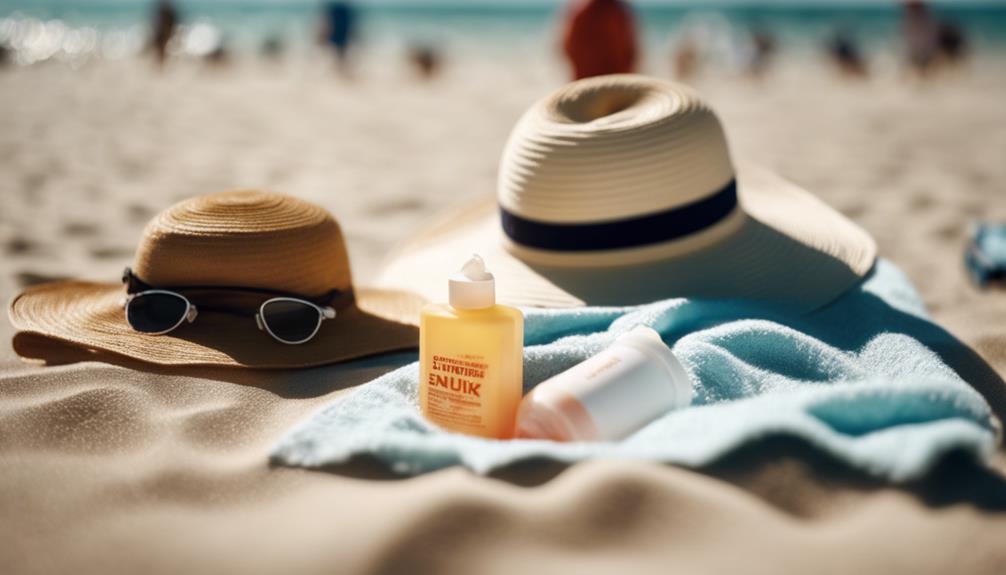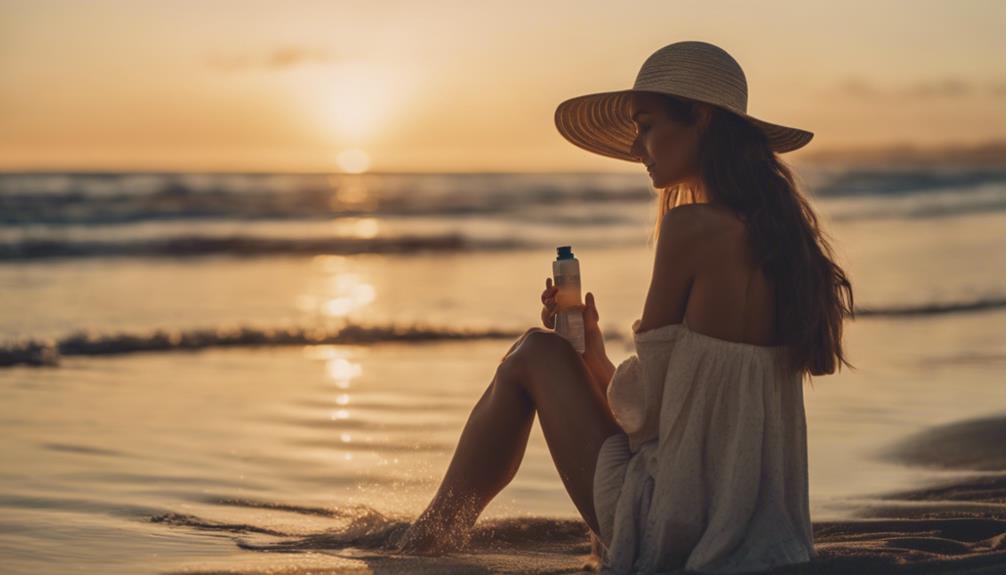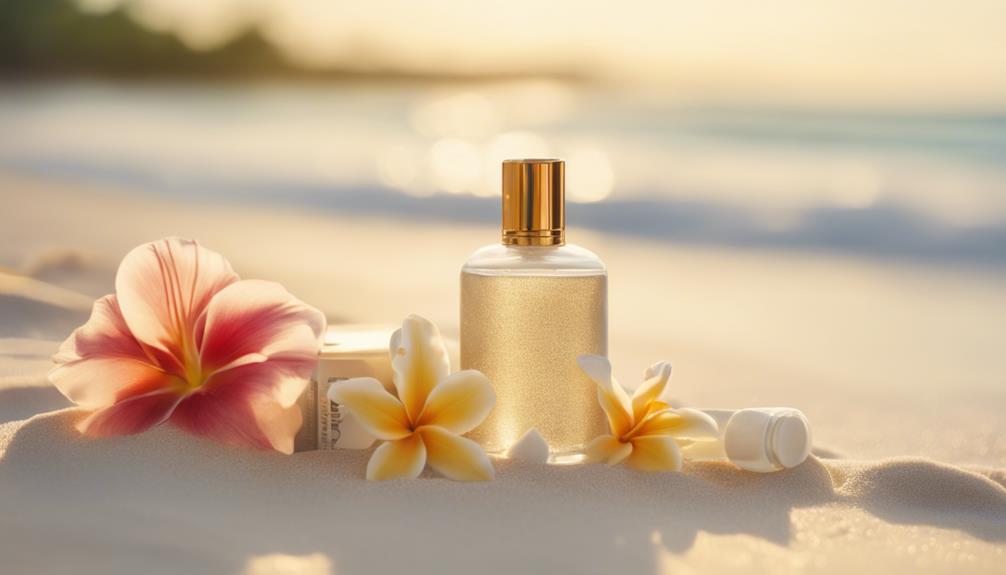You might be making some key tanning mistakes that lead to uneven results or skin issues. Not exfoliating properly can cause patchy skin, while skipping pre-tan moisturizer might leave you with dry patches. If you apply self-tanner with your hands, you risk streaks and unwanted staining. Failing to spot test can result in an overly dark tan. Also, be careful not to shower too soon after tanning; give it time to develop. Don't forget SPF and aftercare for maintaining your glow. Want to know more about these common blunders and how to fix them? Discover tips that can transform your tan!
Key Takeaways
- Skipping exfoliation before tanning leads to patchy results; exfoliate 24 hours prior for a smooth application.
- Neglecting moisturizer causes dry patches that absorb more self-tanner, resulting in uneven color.
- Using hands for application can lead to streaks; always use an applicator mitt for even coverage.
- Overapplying self-tanner on hands and feet creates splotchiness; use leftover product for these areas instead.
Not Exfoliating Properly
One of the biggest tanning mistakes you can make isn't exfoliating properly, which can lead to a patchy and uneven application. To achieve a smooth, flawless tan, you need to exfoliate to remove those stubborn dead skin cells that cling to your skin.
Doing this 24 hours before you apply your self-tanner is ideal, but if you're short on time, a quick exfoliation 4-6 hours before can work in a pinch.
Consider using a body scrub like the Sunday Riley Charcoal Smoothie Jelly Body Scrub, which features salicylic acid and activated charcoal for effective exfoliation. This will help prepare your skin perfectly for the self-tanner.
Instead of using harsh scrubs that can damage your skin, opt for a deluxe mitt to gently buff away dead skin cells.
Skipping Pre-Tan Moisturizer

Skipping a pre-tan moisturizer can lead to dry patches that absorb more self-tanner, resulting in an uneven and splotchy finish.
If you want a flawless tan, it's essential to apply a pre-tan moisturizer. This step keeps your skin hydrated and helps create a barrier against the self-tanner, especially in areas like elbows and knees that tend to soak up more product.
Using a water-based moisturizer specifically designed as a barrier cream can make all the difference. Products like Norvell ProBlend DHA Barrier Cream can help dilute the self-tanner in those extra absorbent spots, preventing those dreaded uneven patches.
When your skin is properly moisturized before application, it guarantees a more uniform tan and a natural appearance, particularly for those with dry skin.
Using Hands for Application

When you apply self-tanner with your hands, you risk streaks and uneven color since your palms absorb more product.
Instead of using your hands, consider a high-quality applicator mitt for a smoother, more even application.
This simple switch can enhance your tan and prevent those dreaded dark patches.
Streaks From Hand Application
Applying self-tanner with your hands can easily lead to uneven coverage and noticeable streaks.
When you use your hands for applying self-tanner, inconsistent pressure and product distribution can result in an uneven finish. Your hands are also more absorbent than other areas of your body, which can cause them to become darker than the surrounding skin. This leads to a mismatched color that's hard to hide.
To avoid this common mistake, consider using an Applicator Mitt.
This tool not only protects your hands from staining but also guarantees a smooth application. With a mitt, you gain better control and blending capabilities, especially in those tricky spots like your back or behind your knees.
Plus, when you blend the self-tanner into your skin using circular motions, you'll markedly reduce the risk of streaks and achieve a flawless tan.
Recommended Applicator Mitts
Using an applicator mitt not only elevates your tanning game but also guarantees a smooth, streak-free application that your hands can't achieve alone.
When applying self-tanner, mitts like the St. Tropez Double-Sided Luxe Velvet Applicator Mitt are essential. They protect your hands from staining while providing better control over the product amount, reducing waste and enhancing the quality of your tan.
The soft texture of a tanning mitt helps you blend self-tanner seamlessly over larger areas, creating a more natural look than when using bare hands. With a mitt, you can easily navigate tricky spots, preventing excessive product build-up on hard-to-tan areas, ensuring an even color throughout.
Don't underestimate the difference a good applicator mitt can make in your tanning routine. By switching to this tool, you'll notice a significant improvement in your application process, leading to a gorgeous, sun-kissed glow without the stress of streaks.
Failing to Spot Test

When you skip spot testing, you risk ending up with a tan that's too dark or uneven.
Always choose inconspicuous areas like your wrist to see how the color develops over time.
Importance of Spot Testing
Failing to spot test a new self-tanner can lead to unexpected and often disappointing results, making it essential to take this simple precaution.
Different self-tanners contain varying DHA concentrations, which can dramatically affect your final color. This is especially true for those with fair skin, where even slight differences can result in an overly dark or orange hue that's tough to fix.
By conducting a spot test, you can determine how the self-tanner interacts with your unique skin tone. It's recommended to apply a small amount on an inconspicuous area, like your wrist, and observe how the tan develops over the next 8 hours.
This quick step can save you time and frustration by ensuring the selected tanner complements your complexion before you commit to a full application.
Choose Inconspicuous Areas
Choosing inconspicuous areas for your spot test, like your wrist or behind the ear, guarantees you can evaluate how the self-tanner interacts with your skin tone without drawing attention. This is especially important because different self-tanners contain varying DHA concentrations, which can dramatically affect the final color on your skin.
If you have fair skin, conducting a spot test is essential to avoid overly dark shades that might result in an undesirable orange appearance. By testing in these hidden spots, you can assess how the formula develops over time, ensuring it complements your complexion perfectly.
Remember to allow up to 8 hours for the color to fully develop before checking the results of your spot test. This patience will help you avoid any surprises when applying the product all over.
Regularly testing new formulas in inconspicuous areas not only prevents undesirable outcomes but also creates a more tailored tanning experience. So, next time you're trying out a new self-tanner, don't skip this step—choose your testing spots wisely and get the best results for your fair skin!
Monitor Color Development Time
Monitoring color development time is essential to guarantee your self-tanner delivers the desired shade without any unpleasant surprises. Failing to spot test can lead to unexpected results, resulting in an unnatural appearance. Here's how you can effectively monitor color development:
- Perform a Patch Test: Always apply the self-tanner in an inconspicuous area, like your wrist. This helps you see how the product interacts with your unique skin tone.
- Observe Over Time: Wait for up to 8 hours after application to see the true color. This gives the self-tanner enough time to fully develop.
- Evaluate the Result: Check the final shade against your expectations. If it's too dark or orange, you may need to choose a different product or shade.
Insufficient Product Application

Insufficient product application often leads to a patchy and uneven tan, making it crucial to apply enough self-tanner for a smooth, consistent glow. When you don't use enough product, your skin absorbs a limited amount of the tanning agent, resulting in streaks and uneven coverage. To avoid this, aim to use at least two pumps of self-tanner per limb. This guarantees effective application and helps prevent patchiness.
Don't forget about those often-overlooked areas, like your armpits and the back of your knees. Neglecting these spots can leave you with a tan that's anything but uniform.
If you're unsure about how much to apply, consider using a gradual tan lotion. This allows you to control the depth of color while minimizing the risk of under-application.
Overapplying on Hands and Feet

When you're applying self-tanner, it's easy to overdo it on your hands and feet.
To avoid that splotchy look, use leftover product from other areas and focus on blending it seamlessly.
Sparing Application Techniques
Applying self-tanner sparingly on your hands and feet is essential to prevent an uneven, splotchy look. These areas absorb self-tanner more easily, which can lead to stained palms or an unnatural darker appearance.
To achieve a flawless tan, follow these tips for sparing application:
- Use Leftovers: After applying product to your arms and legs, use any leftover self-tanner on your hands and feet. This helps create a more natural look without overdoing it.
- Mix with Moisturizer: Consider mixing your self-tanner with a lightweight moisturizer before applying it to your hands and feet. This can help dilute the product, ensuring a balanced application.
- Focus on Blending: When you apply the product, take extra time to blend self-tanner into your wrists and ankles. The goal is to achieve a seamless shift between tanned and untanned skin, preventing harsh lines.
Seamless Blending Techniques
To achieve a flawless tan, mastering seamless blending techniques is vital, especially to prevent overapplication on your hands and feet. When applying self-tanner, start by using leftover product from other body areas to lightly coat your hands and feet. These areas absorb product more readily, so a smaller amount is key to avoid dark spots.
Blending is essential for a natural look. Use a damp makeup sponge or mitt to shift the tanner smoothly from your limbs to your hands and feet. This guarantees an even finish and reduces the risk of splotchiness. Pay special attention to your knuckles, wrists, and ankles by applying a moisturizer beforehand. This creates a barrier that helps prevent these areas from darkening too much.
Also, don't forget to wash your hands immediately after applying the tanner. This step removes any excess product, keeping your palms a natural color and preventing stains.
Showering Too Soon After Tanning

Showering too soon after tanning can wash away the self-tanner before it fully develops, leaving you with uneven color. To achieve that perfect tan, it's crucial to give the self-tanner enough time to set. Most products require up to 8 hours for the color to develop fully, so plan accordingly.
Here are three key tips to guarantee you get the best results:
- Wait Before Showering: Resist the urge to rinse off immediately. Keep your skin dry for at least 8 hours after applying the self-tanner.
- Choose Low-Key Activities: Avoid sweating or engaging in activities that might cause you to wash away your self-tanner. Opt for relaxing, low-energy tasks instead.
- Sleep on Dark Sheets: If you're applying the self-tanner in the evening, use dark sheets to prevent staining while it develops overnight.
Forgetting to Use SPF

Forgetting to use SPF can undermine all the effort you put into achieving that beautiful tan, leaving your skin vulnerable to harmful UV rays. Remember, self-tanner doesn't offer any sun protection. It's vital to apply a broad-spectrum sunscreen with at least SPF 30, like Supergoop Skin Soothing Mineral Sunscreen SPF 40, before heading outdoors.
Apply sunscreen generously from head to toe, even on areas that have already been tanned. This not only helps maintain your skin's health but also prevents painful burns. And don't forget to reapply every two hours, especially if you've been swimming or sweating.
If you're using self-tanner, consider applying it before bed and showering it off in the morning. This method gives you a bronzed look while ensuring you can focus on applying SPF during your daytime activities.
By prioritizing sunscreen, you can enjoy a gorgeous tan without compromising your skin's safety. Protecting your skin with the right SPF is just as important as achieving that perfect glow.
Ignoring Tan Line Corrections

Many people often overlook the importance of correcting tan lines, which can leave your skin looking uneven and detract from your overall glow. To achieve a uniform look, follow these simple steps for effective tan line correction:
- Choose the Right Self-Tanner: Use a darker bronzer formula, like St. Tropez Self-Tan Bronzing Lotion, for better results. This helps to blend the tan lines more seamlessly with the rest of your skin.
- Apply Precisely: For precise correction, grab a Q-tip or a foundation brush. Use it to apply the self-tanner directly to the white lines. This guarantees an even blend without over-applying product.
- Allow Development Time: Let the tanner develop overnight. This maximizes the correction of tan lines, allowing the formula to deepen and blend nicely with your existing tan.
If stubborn tan lines persist, you might need to repeat the application.
Neglecting Skin Aftercare

After perfecting your tan lines, it's easy to overlook the importance of proper skin aftercare, which is essential for maintaining that sun-kissed glow. Neglecting skin aftercare can lead to dryness and flaking, resulting in a patchy appearance.
To keep your tan looking vibrant, you should be moisturizing daily. Choose hydrating products, such as body lotions with DHA or tan extenders, to nourish your skin and prolong your tan's life.
Avoid exfoliating for at least a week after tanning, as scrubbing can strip away the tanning agents, causing uneven fading. It's also important to drink plenty of water post-application; staying hydrated from the inside out helps maintain a healthy glow.
Don't forget to apply sunscreen regularly, even on your beautifully bronzed skin. Protecting yourself from UV damage is essential, as sun exposure can fade your tan prematurely.
Frequently Asked Questions
How to Correct Self-Tanning Mistakes?
To correct self-tanning mistakes, exfoliate uneven areas with baking soda and lemon juice, blend mismatched colors using lotion, and apply baby oil for too much product. Always moisturize high-absorption spots before tanning for a smoother outcome.
Can I Put New Tan Over Old Tan?
Sure, you can put new tan over old tan! Just expect a fun surprise with patchiness and unevenness. It's better to exfoliate first, or try a gradual tanner for a smoother, more flattering result.
Is It Better to Shave Before or After Self-Tanning?
It's better to shave at least 24 hours before self-tanning. This allows your skin to settle, reducing irritation and ensuring a smoother application. Shaving afterward, ideally 8 hours later, helps maintain your tan's appearance.
How to Avoid White Armpits When Tanning?
Imagine your skin as a canvas; to avoid white armpits, exfoliate well, apply moisturizer first, and use a mitt for even application. Less product blends from your arms guarantees a flawless masterpiece. Let it develop!
Are the Tanning Mistakes Also Common Skincare Mistakes for Men?
Yes, common skincare mistakes men often make include not using sunscreen while tanning, leading to sun damage and premature aging. Neglecting to exfoliate can result in a dull complexion, while over-exfoliating can irritate the skin. Not moisturizing can also lead to dryness and wrinkles, so it’s important to have a proper skincare routine.
Conclusion
By avoiding these common tanning mistakes, you can achieve a flawless, sun-kissed glow without the hassle.
Remember, it's not just about looking good; it's about taking care of your skin, too.
Think of your skin as a classic car—if you want it to shine like it did in its prime, you've got to give it the right maintenance.
So, prep, apply, and care for your skin properly, and you'll be rocking that tan like a pro!









